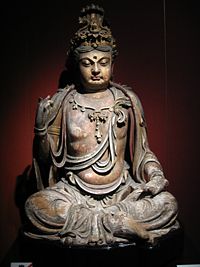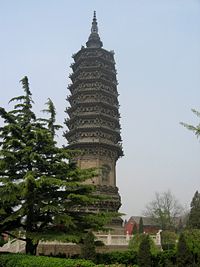Jin Dynasty (1115–1234)
- This is an article for the Jurchen Jin Dynasty (1115–1234). For other Chinese dynasties whose names are also rendered "Jin" in pinyin, see Jin Dynasty.
|
|||||||||||||||||||||||||||||||||
 |
|||||||
|---|---|---|---|---|---|---|---|
| ANCIENT | |||||||
| 3 Sovereigns and 5 Emperors | |||||||
| Xia Dynasty 2100–1600 BCE | |||||||
| Shang Dynasty 1600–1046 BCE | |||||||
| Zhou Dynasty 1122–256 BCE | |||||||
| Western Zhou | |||||||
| Eastern Zhou | |||||||
| Spring and Autumn Period | |||||||
| Warring States Period | |||||||
| IMPERIAL | |||||||
| Qin Dynasty 221 BCE–206 BCE | |||||||
| Han Dynasty 206 BCE–220 CE | |||||||
| Western Han | |||||||
| Xin Dynasty | |||||||
| Eastern Han | |||||||
| Three Kingdoms 220–280 | |||||||
| Wei, Shu & Wu | |||||||
| Jin Dynasty 265–420 | |||||||
| Western Jin | 16 Kingdoms 304–439 | ||||||
| Eastern Jin | |||||||
| Southern & Northern Dynasties 420–589 | |||||||
| Sui Dynasty 581–618 | |||||||
| Tang Dynasty 618–907 | |||||||
| ( Second Zhou 690–705 ) | |||||||
| 5 Dynasties & 10 Kingdoms 907–960 |
Liao Dynasty 907–1125 |
||||||
| Song Dynasty 960–1279 |
|||||||
| Northern Song | W. Xia | ||||||
| Southern Song | Jin | ||||||
| Yuan Dynasty 1271–1368 | |||||||
| Ming Dynasty 1368–1644 | |||||||
| Qing Dynasty 1644–1911 | |||||||
| MODERN | |||||||
| Republic of China 1912–1949 | |||||||
| People's Republic of China (Mainland China) 1949–present |
Republic of China |
||||||
|
Related Articles
|
|||||||
The Jīn Dynasty (Jurchen: Anchu, Aisin Gurun; Chinese: 金朝; pinyin: Jīn Cháo Wade-Giles Chin Dynasty; Mongolian: Altan Ulus; 1115–1234), also known as the Jurchen Dynasty, was founded by the Wanyan (完顏 Wányán) clan of the Jurchens, the ancestors of the Manchus who established the Qing Dynasty some 500 years later. The name is sometimes written as Jinn to differentiate it from an earlier Jìn Dynasty of China whose name is spelled identically in the Roman alphabet.
Contents |
History
The Jin Dynasty was founded in what would become northern Manchuria by the Jurchen tribal chieftan Wányán Āgǔdǎ (完顏阿骨打) in 1115. In 1125, it successfully annihilated the Liao Dynasty which had held sway over northern China, including Manchuria and part of the Mongol region for several centuries. Also at this time, the Jin made overtures to the Korean kingdom of Goryeo, which Emperor Yejong refused.[1] On January 9, 1127, Jin forces ransacked Kaifeng, capital of the Northern Song Dynasty, capturing both Emperor Qinzong, and his father, Emperor Huizong, who had abdicated in panic in the face of Jin forces. Following the fall of Kaifeng, Song forces under the leadership of the succeeding Southern Song Dynasty continued to fight for over a decade with Jin forces, eventually signing the Treaty of Shaoxing in 1141, calling for the cessation of all Song land north of the Huai River to the Jin and the execution of Song General Yue Fei in return for peace.
The migration south

After taking over Northern China, the Jin Dynasty became increasingly Sinicized. About three million people, half of them Jurchens, migrated south into northern China over two decades, and this minority governed about thirty million Chinese. The Jurchens were given land grants and organized society into 1,000 households (猛安 - meng'an) and 100 households (謀克 - mouke). Many married Hans, although the ban on Jurchen nobles marrying Hans was not lifted until 1191. After Jin Emperor Tàizōng (太宗) died in 1135, the next three Jin emperors were grandsons of Wányán Āgǔdǎ by three different princes. Young Jin Emperor Xīzōng (熙宗) (r. 1135-1149) studied the classics and wrote Chinese poetry. He adopted Han cultural traditions, but the Jurchen nobles had the top positions.
Later in life, Emperor Xīzōng became an alcoholic and executed many officials for criticizing him. He also had Jurchen leaders who opposed him murdered, even those in his own Wanyan family clan. In 1149 he was murdered by a cabal of relatives and nobles, who made his cousin Wányán Liàng (完顏亮) the next Jin emperor. Because of the brutality of both his domestic and foreign policy, Wanyan Liang was posthumously demoted from the position of emperor. Consequently, historians have commonly referred to him by the posthumous name of Prince Hǎilíng (海陵王).[2]
Rebellions in the north
In 1153, Prince Hǎilíng moved the empire's "southern" capital from Huining Fu in northern Manchuria (south of present-day Harbin) to Zhongdu (now Beijing). Four years later in 1157, he razed Beijing, including the nobles’ residences, and moved the Jurchen southern capital from Beijing to Kaifeng and began to reconstruct it (since its sack in 1127). Prince Hǎilíng also tried to suppress dissent by killing Jurchen nobles, executing 155 princes.[2]
Emperor Prince Hǎilíng attacked the Southern Song in 1161. Meanwhile, two simultaneous rebellions of Jurchen nobles, led by soon-to-be crowned Wányán Yōng (完顏雍), and Khitan tribesman erupted in Manchuria, forcing the Jin Dynasty to withdraw its troops from southern China to quell the uprisings. The Jin were defeated in the Battle of Caishi and Battle of Tangdao. With a depleted military force, Prince Hǎilíng failed to make headway in his attempted invasion of the Song. Finally he was assassinated by his own generals in December of 1161. His son and heir was also assassinated in the capital. Although crowned in October, Wányán Yōng was not officially recognized as Jin Emperor Shìzōng (世宗) until the murder of Prince Hǎilíng's heir.[2] The Khitan uprising was not suppressed until 1164; their horses were confiscated so that the rebels had to take up farming. Other Khitan and Xi cavalry units had been incorporated into the Jin army. Because these internal uprisings had severely weakened the Jin’s capacity to confront the Southern Song militarily, the Jin court under Emperor Shizong began negotiating for peace. The Treaty of Lóngxīng (隆興和議) was signed in 1164 and ushered over 40 years of peace between the two empires.

In the early 1180s Emperor Shìzōng instituted a restructuring of 200 meng'an units to remove tax abuses and help Jurchens. Communal farming was encouraged. The Jin empire prospered and had a large surplus of grain in reserve. Shìzōng's grandson, Emperor Zhāngzōng (章宗) (r. 1189-1208) venerated Jurchen values, but he also immersed himself in Chinese culture and married an ethnic Han woman. The Taihe Code of law was promulgated in 1201 and was based mostly on the Tang Code. In 1207 the Song tried to invade, but the Jin forces effectively repulsed them. In the peace agreement the Song had to pay higher annual indemnities and behead Hán Tūozhòu (韩侂胄), the leader of their war party.[3]
Fall under the Mongol Empire
Starting from the early 13th century the Jin Dynasty began to feel the pressure of Mongols from the north. Genghis Khan first led the Mongols into Western Xia territory in 1205 and ravaged them four years later. In 1211 about 50,000 Mongols on horses invaded the Jin Empire and began absorbing Khitan and Jurchen rebels. The Jin army had a half million men with 150,000 cavalry but abandoned the “western capital”. The next year the Mongols went north and looted the Jin “eastern capital”, and in 1213 they besieged the “central capital”. In 1214 the Jin made a humiliating treaty but retained the capital. That summer, Jin Emperor Xuānzōng (宣宗) abandoned the central capital and moved the government to the “southern capital” of Kaifeng, making it the official seat of Jin Dynasty power. In 1216 a war faction persuaded Xuānzōng to attack the Song, but in 1219 they were defeated at the same place by the Yangtze River, where Prince Hǎilíng had been defeated in 1161. Jin Emperor Āizōng (哀宗) won a succession struggle against his brother and then quickly ended the war and went back to the capital. He made peace with the Tanguts, who had been allied with the Mongols. Genghis Khan died in 1227 while his armies were conquering the Western Xia Dynasty. His son Ögedei Khan invaded the Jin Empire in 1232 with assistance from the Southern Song. The Jurchens tried to resist; but when Kaifeng was attacked, Āizōng fled south. The Mongols looted the capital in 1233, and the next year Āizōng committed suicide to avoid being captured, ending the Jin dynasty in 1234.[2]

In his book Empire of The Steppes, Grousset reports that the Mongols were always amazed at the valor of the Jin warriors, who held out until seven years after the death of Genghis Khan himself.
Rise of the Manchus
After thirty years of struggle, the Jurchen chief Nurhaci (努爾哈赤) combined the three Jurchen tribes and founded the Later Jin Dynasty (1616-1636). Nurhaci's eighth son and heir, Huáng Tàijí (皇太極), later changed the name of his people from Jurchen to Manchu in 1635. The next year, he changed the name of the Latter Jin to Qing in 1636.
| Temple Name Miao Hao 廟號 miàohào |
Posthumous Name Shi Hao 諡號 shìhào |
Birth Name 姓名 xìngmíng |
Years of Reign |
Era Name Nian Hao 年號 niánhào and Years |
|---|---|---|---|---|
| Convention: "Jin" + temple name or posthumous name | ||||
| Tàizǔ 太祖 |
(1) | Wányán Āgǔdǎ 完顏阿骨打 |
1115-1123 |
Shōuguó (收國, 1115-1116) |
| Tàizōng 太宗 |
(1) | Wányán Wúqǐmǎi 完顏吳乞買 or Wányán (Shèng or Chéng) 完顏晟 |
1123-1134 | Tiānhuì (天會, 1123-1134) |
| Xīzōng 熙宗 |
(1) | Wányán Hélá 完顏合剌 or Wányán Dǎn 完顏亶 |
1135-1149 |
Tiānhuì (天會, 1135-1138) |
| (2) | Hǎilíngwáng 海陵王 |
Wányán Dígǔnǎi 完顏迪古乃 or Wányán Liàng 完顏亮 |
1149-1161 |
Tiāndé (天德, 1149-1153) |
| Shìzōng 世宗 |
(1) | Wányán Wūlù 完顏烏祿 or Wányán Yōng 完顏雍 |
1161-1189 | Dàdìng (大定, 1161-1189) |
| Zhāngzōng 章宗 |
(1) | Wányán Jǐng 完顏璟 |
1190-1208 | Míngchāng (明昌, 1190-1196) Chéng'ān (承安, 1196-1200) |
| (2) | Wèishàowáng 衛紹王 or Wèiwáng 衛王 |
Wányán Yǒngjì 完顏永濟 |
1209-1213 | Dà'ān 大安 1209-1212 Chóngqìng |
| Xuānzōng 宣宗 |
(1) | Wányán Xún 完顏珣 |
1213-1223 | Zhēnyòu 貞祐 1213-1217 Xīngdìng |
| Āizōng 哀宗 |
(1) | Wányán Shǒuxù 完顏守緒 |
1224-1234 | Zhèngdà 正大 1224-1232 Kāixīng |
| (2) |
Mòdì 末帝 |
Wányán Chénglín 完顏承麟 |
1234 | (2) |
(1) Quite long and thus not used when referring to this sovereign.
(2) Did not exist
See also
- Puxian Wannu


